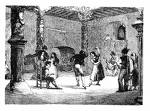
This pretty though now somewhat old-fashioned dance was, before the introduction of the Deux Temps and Polka, a principal feature in every ballroom. It is danced with the step and music of the Old Valse a Trois Temps, played slower than the music of the Deux Temps.
Sometimes the couples stand in two long parallel lines, as in a country dance; sometimes they are arranged in a circle. The leading gentleman must be on the ladies’ side, and his partner on the gentleman’s side. Every fourth lady and gentleman exchange places, to avoid the necessity of keeping the other couples waiting. The whole set can thus begin at the same moment.
Leading gentleman and second lady advance and retreat with Valse step, and change places. Leading lady and second gentleman do the same at the same time.
Leading gentleman and his partner advance and retreat, and change places. Second lady and gentleman do the same at same time. Leading gentleman and second lady repeat this figure; first lady and second gentleman likewise, at same time.
Leading gentleman and first lady repeat same figure; second gentleman and lady repeat at same time.
All four, joining hands, advance to centre, and retreat. Ladies pass to the left. Repeat three times. Each gentleman takes his partner, and the two couples valse round each other once or twice at pleasure; the second lady and gentleman being left at the top of the figure, as in a country dance. Leading gentleman and partner repeat same figure with succeeding couple to end of dance.
It is obvious that there must be an equal number of couples; and that they must be arranged in sets of four, eight, sixteen, twenty, twenty-four, and so on.
*******
This is taken from Routledge's Manual of Etiquette.
Copyright © D. J. McAdam· All Rights Reserved